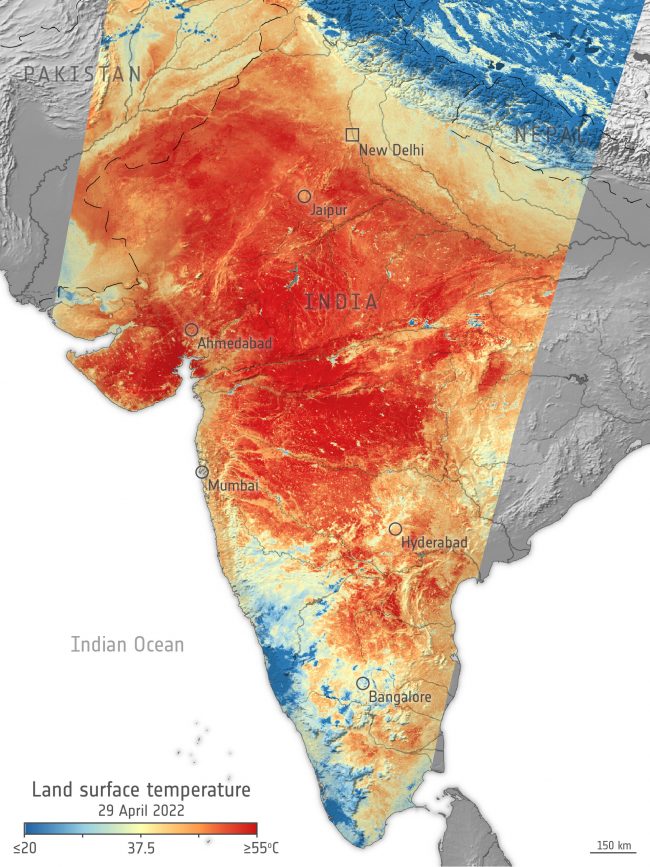
Will the heatwave in India break in time for Eid?
An unprecedented heatwave in South Asia this month has brought dangerously high temperatures to over a billion people this week. India and Pakistan have been hit the hardest. Temperatures topped 113 degrees F (45 degrees C), but the World Meteorological Organization said today (April 29, 2022) that temps in parts of India may ease by May 2, which corresponds to the date of Eid, a major Muslim holiday. Meanwhile, experts suggest that the heat in parts of Pakistan and northwestern India will likely continue through next week.
The heatwave began in late March for northern India and Pakistan and spread into the first weeks of April. Although heatwaves are not uncommon in this region during the pre-monsoon season from April to June, residents and meteorologists have noted that this heatwave was the earliest they could remember.
Some observers are suggesting this heatwave pattern might become one of the longest-lasting in recent decades. Some are calling this year the year without a spring.
Heatwave in India: Diet and nutrition tips to remain healthy
The #heatwave in #India and #Pakistan is hitting many millions of people and the economy. Temps topped 45°C (113°F), will ease by 2 May#Heatwaves are one of the signs of #climatechange
Air temps at 1200 UTC from @CopernicusECMWF
WMO roundup at https://t.co/au1UovUieL pic.twitter.com/wGuZXIU2yS— World Meteorological Organization (@WMO) April 29, 2022
More heat for coming weeks
The average temperature in India in March 2022 was about 92 degrees F (33 degrees C), the warmest March ever recorded since records began in 1902.
Forecast models vary for different parts of the Indian subcontinent. Some models indicate that parts of Pakistan and northwestern India could reach temperatures near 120 degrees F (50 degrees C) over the weekend and through next week. Major cities such as Delhi and Lahore are forecast to reach 113 degrees F (45 degrees C). These temperatures are 18 degrees F (10 degrees C) warmer than the normal high temperatures for April, and would approach the all-time record temperatures for the month. Temperatures in major metropolitan areas can be further exacerbated by the urban heat island effect, increasing local temperatures a few degrees higher than the surrounding countryside.
Due to these forecasts, officials issued heat wave warnings for 10 major cities in India. Last week, some regional educational systems shut down all schools for five days. Heat wave conditions should last at least eight more days before abating.
Dust-Thunderstorm/Rain Predicted during Eid Holidays
(Heat Wave Conditions likely to Subside during the Period)westerly wave is likely to enter western part of the country from 01st May and likely to persist till 05th May (Thursday). #HeatWaves #ThunderStrom#DustStrom pic.twitter.com/Ql1XoBrGgl
— Pak Met Department ????? ??????? (@pmdgov) April 29, 2022
And there’s a rainfall deficit
In addition to the heat, the region has also recorded a significant rainfall deficit in the pre-monsoon season since early March. According to the Indian Meteorological Department, many Indian regions are experiencing a 99% deficit in normal rainfall amounts.
There are growing concerns about the potential for regional food shortages if the lack of rainfall continues.
Unusually high temperatures also spread north and east through Asia. Temperatures reached over 95 degrees F (35 C) in both China and Taiwan. South Korea measured temperatures around 86 degrees F (30 C) earlier this month, coming close to nationwide records for the month of April.
Technically, the heat hasn’t been one continuous heatwave since the beginning of March. Still, this spring will likely be one of the warmest two-month periods on record for South Asia.
Heatwaves develop under high pressure systems that can form south of the jet stream. In Eastern Asia, a stubborn “ridge” in the jet stream has remained persistent since early March, allowing the high pressure system over the region to become unusually strong. This traps the atmosphere in a heat dome that can last for days or even weeks. Relief usually comes in the form of rainfall or a cold front.
Experts don’t expect the monsoon season to begin until June or July for much of the region. So it’s possible the heat in South Asia will continue into the summer months.
A heatwave is a silent killer
Heatwaves are a “hidden” type of severe weather, according to the World Health Organization. They are often overlooked as a dangerous type of weather that can kill. Whether through strained power grids or reductions in water availability, heatwaves hey can quietly kill thousands of people living in vulnerable situations.
In 2015, a similar heatwave (hot enough to melt roads) killed over 500 people in New Delhi alone. The elderly or sick are the most likely to be impacted, but everyone outdoors or without air conditioning are at risk from extreme temperatures.
Bottom line: An unprecedented heatwave in India and Pakistan in April 2022 has brought dangerously high temperatures to over a billion people. Some experts predict May 2 – corresponding with the date of Eid – for when the heat will end.











